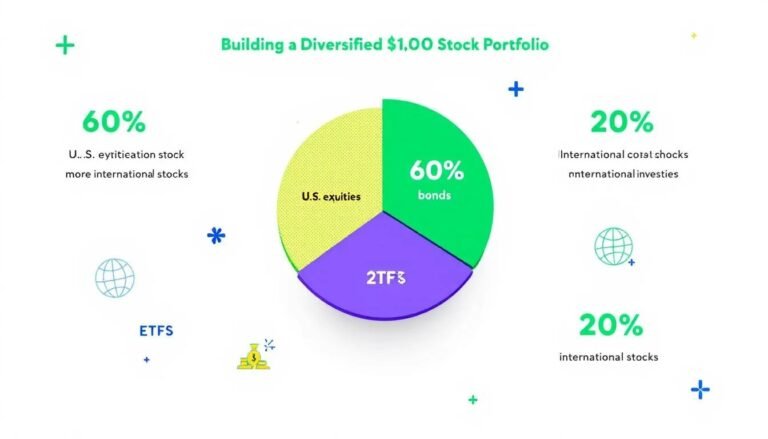
How to Build a Diversified Stock Portfolio with Just $1,000
Investing can feel intimidating when you only have $1,000 to start. However, that modest sum is more than enough to begin building a well-rounded stock portfolio that mitigates risk and positions you for long-term growth. Moreover, by following a clear, step-by-step framework, you’ll avoid common pitfalls like overconcentration or emotional trading.
In this guide, you’ll learn:
- Why diversification matters for every investor
- How to allocate your first $1,000 across asset classes
- Low-cost tools and brokers to get you started
- Practical steps for choosing ETFs, mutual funds, and individual stocks
- Risk management strategies such as dollar-cost averaging and rebalancing
Consequently, by the end of this article, you’ll have an actionable roadmap to turn your first grand into a diversified investment portfolio tailored specifically for beginners.
Why Diversification Matters in Building Your Stock Portfolio?
Diversification is the process of spreading your capital across different investments so that poor performance in one area doesn’t sink your entire portfolio. In contrast to betting everything on a single stock, diversification smooths out returns and reduces volatility.
First, diversification reduces overall portfolio volatility. For example, when the technology sector dips, defensive sectors like consumer staples or utilities may hold steady or even appreciate. As a result, your portfolio experiences fewer dramatic swings.
Second, diversification limits single-stock risk. Rather than risking your entire $1,000 on one company—where an earnings miss or regulatory setback could wipe out your gains—you spread that risk across multiple holdings. This approach ensures that one bad day for one stock doesn’t derail your entire investment journey.
Furthermore, diversification captures growth across multiple sectors. For instance, if healthcare and industrials outperform while energy lags, a balanced portfolio still generates positive returns. Recent MarketWatch coverage on retail ETF inflows highlights how small-cap investors who lacked diversified exposure faced severe drawdowns during 2024’s market rotation. Consequently, a balanced approach would have softened the impact of those roller-coaster moves.
Understanding Asset Allocation in Stock Portfolio
Asset allocation refers to the percentage of your portfolio invested in major asset categories—typically equities, bonds, and international stocks. Therefore, choosing the right allocation is critical for balancing risk and reward.
For a $1,000 starter portfolio, consider a simple three-fund split:
- 60% Equity ETFs
- 20% Bond Funds
- 20% International Stock ETFs
Why This Mix?
- Equity ETFs provide broad U.S. market growth, allowing you to capture gains in large-cap, mid-cap, and small-cap companies without buying individual stocks.
- Bond funds add stability and generate income when equities slump, acting as a cushion during downturns.
- International ETFs tap growth opportunities in Europe, Asia, and emerging markets—areas that often move independently of U.S. markets.
Moreover, historical data shows that a 60/20/20 portfolio outperforms pure equity portfolios during down-market years, thanks to the stabilizing role of bonds and geographic diversification. Consequently, while you can tweak these weights based on your individual risk tolerance and investment horizon, the 60/20/20 split serves as a reliable baseline for beginners.
Step‐by‐Step Guide: Allocating Your First $1,000
Building your portfolio with just $1,000 is straightforward when you follow these concrete steps:
- Choose a commission-free broker (see next section).
- Fund your account with $1,000.
- Execute three purchases:
- $600 into a total U.S. stock ETF (e.g., Vanguard Total Stock Market ETF – VTI)
- $200 into a total bond market ETF (e.g., iShares Core U.S. Aggregate Bond ETF – AGG)
- $200 into an international stock ETF (e.g., Vanguard FTSE All-World ex-US ETF – VEU)
- Set up an automatic monthly deposit of $100 to leverage dollar-cost averaging.
- Review and rebalance every six months to maintain your 60/20/20 targets.
By automating deposits and scheduling periodic rebalances, you eliminate emotional decision-making and ensure discipline. Furthermore, this systematic approach smooths out the impact of market volatility over the long run.
Choosing the Right Broker
Selecting the right brokerage is crucial, especially when you’re starting with limited capital. Therefore, look for these key features:
Key Broker Features for Beginners
- No-minimum account requirements, so you can start immediately with $1,000.
- Zero commission on ETFs and stocks, ensuring that trading costs don’t eat into your small balance.
- Fractional shares, which allow you to buy partial shares of expensive stocks like Amazon (AMZN) or Alphabet (GOOGL) without needing hundreds of dollars per share.
- User-friendly mobile app and platform, so you can monitor and manage your investments on the go.
Popular broker options include:
- Robinhood: Known for zero commissions and intuitive interface.
- Fidelity: Offers no-fee ETFs, robust research tools, and excellent customer service.
- Webull: Provides extended trading hours, paper-trade simulator, and advanced charting.
Consequently, weigh these features against your personal preferences—whether you value research tools, simplicity, or advanced order types—to pick a broker that aligns with your goals.
Picking Your Investments for Your Stock Portfolio
With limited capital, ETFs often make the most sense for immediate diversification. However, as your portfolio grows, you might selectively add individual stocks for higher upside potential.
Why Start with ETFs Stock?

- Instant Diversification: One purchase can provide exposure to hundreds or thousands of companies.
- Low Expense Ratios: Many broad-market ETFs charge less than 0.10% annually.
- High Liquidity: Traded like single stocks, so you can buy or sell anytime during market hours.
Adding Individual Stock
Once your ETF core is in place, consider sprinkling in 1–3 individual names:
- Focus on large-cap, blue-chip stocks with strong balance sheets and consistent dividend histories.
- Limit each stock to no more than 5%–10% of your total portfolio value.
- Leverage fractional shares to establish positions in high-price names with just a few dollars.
For idea generation, you can consult MarketWatch’s “Most Active Stocks” list or Yahoo Finance’s trending tickers. This external research helps you identify stocks with strong momentum or attractive valuations.
Sector Diversification Examples
Even within equities, it’s wise to spread your ETF or stock picks across major sectors. This layering adds another buffer against sector-specific downturns.
Consider allocating as follows in your $1,000 portfolio:
- $400 into a Total Market ETF (broad exposure)
- $100 into a Technology ETF (e.g., XLK)
- $100 into a Healthcare ETF (e.g., XLV)
- $100 into a Financials ETF (e.g., XLF)
- $100 into an International ETF (e.g., VEU)
- $200 into a Bond ETF (e.g., AGG)
This allocation ensures you’re not overly concentrated in any one sector. Furthermore, by including both cyclical (technology, financials) and defensive (healthcare, consumer staples) sectors, you balance growth and stability.
Risk Management Strategies

Implementing robust risk management is crucial, especially when starting small. Above all, these strategies help protect your capital and reinforce discipline.
Dollar-Cost Averaging (DCA)
Investing fixed amounts at regular intervals reduces the risk of poor timing. If prices fall, your periodic investment buys more shares; if prices rise, you buy fewer. As a result, your average cost per share smooths out over time.
Rebalancing Portfolio
Every 6–12 months, review your portfolio and realign it back to your target weights (60/20/20). Sell portions of assets that have grown overweight and buy those that are underweight. Consequently, this enforces a “buy low, sell high” discipline.
Emergency Cash
Before committing your entire $1,000, maintain a 3–6 month cash cushion in a high-yield savings account. This buffer prevents you from liquidating investments during market downturns or personal emergencies, preserving your long-term strategy.
Monitoring and Adjusting Your Stock Portfolio

Regular monitoring ensures your portfolio remains aligned with your objectives. Therefore, adopt the following routine:
- Monthly Review: Quickly check performance versus benchmarks and news headlines.
- Semi-Annual Rebalance: Realign allocations to your 60/20/20 targets.
- News Alerts: Subscribe to MarketWatch or Yahoo Finance for sector rotation insights and Fed policy updates.
By staying informed, you can tweak your strategy as economic conditions evolve. For example, if bond yields rise sharply, you might temporarily shift a portion of bond funds into short-duration assets to preserve capital.
Building a diversified stock portfolio with just $1,000 is not only possible—it’s smart. By concentrating on broad-market ETFs, layering in bonds and international exposure, and managing risk through dollar-cost averaging and rebalancing, you establish a solid foundation for steady, long-term growth.
Ultimately, the key is consistency. Therefore, open an account, fund it with your first $1,000, and execute the 60/20/20 portfolio today. Subsequently, monitor your progress, stay disciplined, and adjust as needed.
What allocation mix are you most excited to try? Share your plan in the comments below!